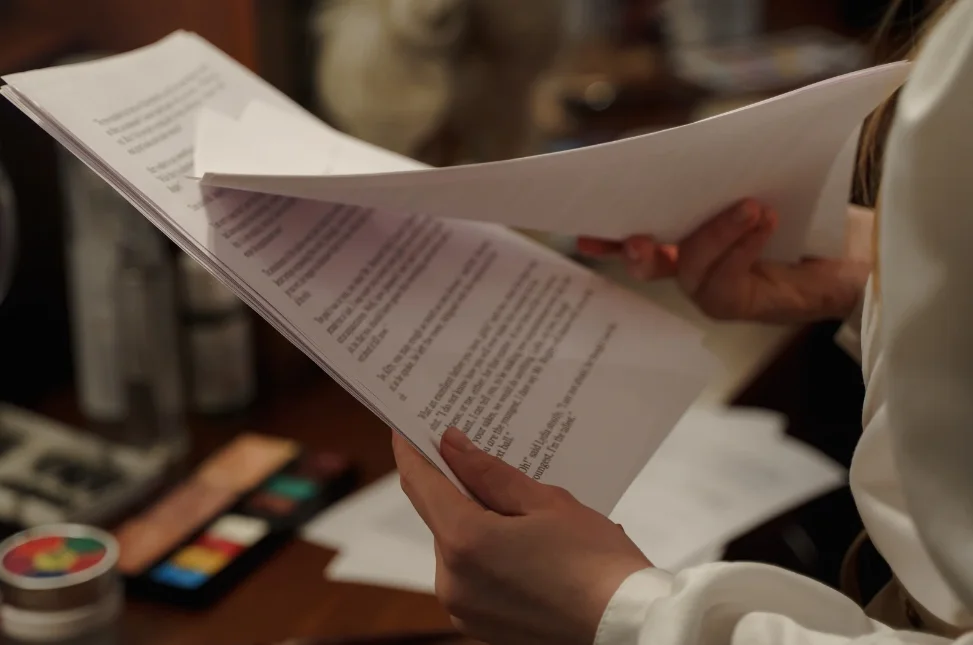From Idea to Script: The Essential Guide

Scriptwriting is a craft that requires a fine balance between creativity and technical know-how. If you have a story to tell and you’re aiming for the screen or the stage, understanding the nuts and bolts of scriptwriting is your first step. The process might seem intimidating, but it’s less about innate talent and more about learning the ropes. A well-written script is the backbone of any successful production, but getting there involves more than just putting pen to paper or fingers to keyboard.
This guide is a straightforward walkthrough of the scriptwriting process. We start with the basics of script formats because, in this industry, details like margins and spacing can be as critical as your narrative. Then, we guide you through the actual writing of your script, giving you a step-by-step approach to developing your story into a working draft. We’ll also address common stumbling blocks writers encounter and offer practical advice for overcoming them. To round it out, there's a Q&A section to fine-tune your skills. By the end, you’ll have a clear roadmap for writing a script that’s ready for the critical eyes of the industry.
Understanding Script Formats
A well-formatted script is the foundation of a successful production. Each element is designed to convey specific information clearly and concisely to the entire production team.
| Element | Function | Example | Notes |
|---|---|---|---|
| Scene Headings | Indicate the location, time, and whether the scene is inside (INT.) or outside (EXT.). | INT. COFFEE SHOP - DAY locations library | - Known as slug lines - Orient the reader to the setting |
| Action Lines | Describe the visual elements, character actions, and setting details. | A barista STEAMS milk, the frothy sound filling the room. | - Present tense - Paint a clear picture |
| Character Names | Presented before their dialogue, centered, and in all caps. | JANE | - Brief description on first introduction - Name only afterwards |
| Dialogue | The spoken words of the characters. | JANE (to the barista) Could I get an extra shot in that, please? | - Natural, concise - Use parentheticals for tone/action clarification |
| Parentheticals | Provide specific direction for the actor's delivery of the dialogue. | (smiling warmly) | - Below character's name - Use sparingly |
| Transitions | Editorial directions for how one scene moves to the next. | CUT TO: | - Used sparingly - Often director's discretion |
To streamline the formatting process, consider using screenwriting software like Final Draft, Celtx, or WriterDuet, which automatically align your script to industry standards.
A Step-by-Step Guide to Writing Your Script
From initial concept to final draft, the scriptwriting process is a meticulous journey. Here's a structured guide to crafting a screenplay that resonates with audiences and meets industry standards.
Step 1: Conceptualizing Your Story

Every great script starts with a seed of inspiration. To germinate this seed, immerse yourself in brainstorming sessions where no idea is too small or too wild. Jot down various story ideas, considering the themes, messages, and emotional journeys you wish to convey. Organizational tools like mind maps or storyboards can be invaluable at this stage, helping you to structure your thoughts and refine your story's foundation.
- Engage in brainstorming sessions to capture a wide array of story ideas.
- Delve into the themes, messages, and emotional arcs that will drive your narrative.
- Utilize organizational tools such as mind maps or storyboards to structure and refine your story ideas.
Step 2: Outlining the Plot

With your story's concept in hand, it's time to lay down its structural bones through a robust outline. This narrative skeleton will map out the trajectory of your script, ensuring that your story has a clear beginning, middle, and end.
- In Act I, set the stage by introducing the world, characters, and the inciting incident that triggers the plot.
- Act II is where the heart of your story beats, filled with escalating conflicts and deepening character arcs.
- Conclude with Act III, bringing your story to a climax and offering resolution that ties up the narrative threads in a satisfying manner.
Step 3: Crafting a Treatment

Before diving into the script itself, take a step back to create a treatment. This document is a narrative blueprint, offering a bird's-eye view of your screenplay. It's a concise yet comprehensive guide that outlines the journey your characters will undertake and the major plot points they will encounter.
- Summarize the central narrative, capturing the essence of the story in a snapshot.
- Introduce key characters and outline their developmental arcs throughout the story.
- Provide an overview of the story's progression, mapping out the key events and turning points.
Step 4: Starting Your Script

The opening of your script is your chance to make a powerful first impression. Here, you will craft the initial scenes that set the tone and establish the world of your screenplay. From the title page to the first slice of dialogue, each element must be meticulously chosen to captivate the reader.
Title Page:
The Title Page should be simple yet formal, presenting the script's title, your name, and contact information.
[Example]
Title of Your Script Written by Your Name Contact Information
Scene Heading:
Scene Headings guide the reader through the locations and times of your story, setting the stage for what's to come.
INT. KITCHEN - MORNING
Action Lines:
Action Lines paint a vivid picture of the setting and characters, bringing the world of your script to life.
[Example]
Golden sunlight pierces the quiet of the kitchen. JAMES (35, weary-eyed) sits at the table, his gaze lost in the steam rising from a hot cup of coffee.
Dialogue:
Dialogue introduces us to the characters through their spoken words, offering insight into their personalities and relationships.
[Example]
Golden sunlight pierces the quiet of the kitchen. JAMES (35, w
[Example]
JAMES (murmuring to himself) Here's to hoping for a better day.
Step 5: Completing the First Draft

With the groundwork laid, it's time to let your creativity flow and pen the first draft of your script. This draft is about momentum and capturing the essence of your story on the page, not getting bogged down by the pursuit of perfection.
- Scene Execution: Write each scene using your outline as a guide.
- Narrative Pace: Maintain a steady flow of action and dialogue.
- Character Voices: Ensure each character's dialogue is distinct and true to their personality.
Step 6: Revising Your Draft

After completing your first draft, the revision process begins. This is where you refine your script, enhancing its strengths and addressing its weaknesses. Take a break from your draft to return later with a fresh perspective.
- Rest and Return: Step away from your draft to gain perspective.
- Critical Analysis: Evaluate the pacing, dialogue, and character development.
- Peer Review: Incorporate feedback from trusted colleagues or writing groups.
Step 7: Ensuring Proper Format

Formatting your script correctly is essential, as it demonstrates professionalism and respect for industry norms. This step involves a thorough review of your screenplay's formatting, ensuring that every element aligns with standard practices.
| Formatting Focus | Description |
|---|---|
| Scene Headings | Verify correct formatting for scene locations and times. |
| Action Lines | Check for clear, concise descriptions in the present tense. |
| Character Introductions | Ensure character names are capitalized and introductions are brief. |
| Dialogue | Confirm dialogue is properly formatted and authentic to each character. |
| Parentheticals | Use only when necessary to inform how lines should be delivered. |
| Transitions | Use judiciously, as these often fall under the director's purview. |
Step 8: Finalizing Your Script

The finalization of your script is a meticulous process of proofreading and polishing. This is your last opportunity to ensure that your screenplay is error-free and formatted consistently, ready to be presented to the world.
- Scrutinize every detail, correcting any spelling, punctuation, and grammar errors.
- Double-check for consistency in formatting, ensuring a clean and professional appearance throughout the script.
- Confirm that your script is polished, professional, and ready to make a memorable impression on its readers.
Troubleshooting Common Scriptwriting Issues

Encountering challenges in scriptwriting is a natural part of the creative process. To help you overcome these hurdles, here are strategies presented in a distinct format, offering clarity and actionable advice.
Overcoming Writer's Block
- Strategy: Change your writing scene or switch to a different creative activity before returning to your script.
- Resource: Consider writing prompt tools or software with creative prompts like Scrivener.
Correcting Formatting Errors
- Strategy: Get to know the standard formatting rules better and let scriptwriting software aid you.
- Resource: Keep a copy of "The Screenwriter's Bible" on hand, or utilize formatting programs like WriterDuet.
Refining Dialogue
- Strategy: Speak your characters' lines out loud to test for authenticity and revise as needed.
- Resource: Observe real-life dialogue or use tools like Grammarly to analyze and improve dialogue flow.
Fixing Pacing Issues
- Strategy: Re-examine your script's flow, trimming or expanding scenes to ensure consistent narrative rhythm.
- Resource: Use organizational tools such as Trello to plot out your scenes and adjust for optimal pacing.
Q&A: Sharpening Your Scriptwriting Techniques

We've curated a selection of frequently asked questions paired with straightforward answers to address typical scriptwriting concerns. This Q&A format is intended to serve as a quick consultation tool, offering you targeted guidance to refine your scriptwriting techniques.
Q: What's the best way to learn from industry-standard scripts?A: Study and breakdown well-crafted scripts from notable films to see how they handle plot and character development.
Q: How can I make my characters' dialogue more believable?A: Observe the nuances of real-world speech and infuse these elements into your script's dialogue. Organize readings to fine-tune any lines that don't ring true.
Q: How can I build a consistent writing habit?A: Dedicate specific times for writing sessions and use the Pomodoro Technique or similar methods to keep your writing on track and manage procrastination.
Q: Why is networking with other scriptwriters important?A: Interacting with peers can provide you with diverse perspectives and feedback, while also helping you build connections that may lead to collaborative opportunities.
Q: What aspects should I focus on when editing my script?A: Be ready to revise your work multiple times, focusing on both content and technical aspects. Scriptwriting software like Final Draft can be invaluable for making structural changes and ensuring correct formatting.
Implementing these Q&A tips into your writing routine will lead to more polished scripts. Embrace the process of learning and revising, as each iteration of your script moves you closer to a finished piece that's ready for the spotlight.
Key Takeaways for Aspiring Scriptwriters

As we conclude, remember that scriptwriting is a skill that flourishes with practice and a solid grasp of storytelling essentials. Through the steps detailed in our guide, you've learned how to take your script from a concept to a polished piece ready for the eyes of producers and directors. Make sure to use specialized scriptwriting software to keep your format in check, and don't hesitate to seek feedback to improve your drafts.
Ultimately, your journey as a scriptwriter is about persistence and continuous improvement. Keep refining your technique, stay open to revising your work, and keep your enthusiasm for crafting engaging stories alive. With dedication, your scripts will evolve, ready to capture the imagination of audiences and lead you down the path of a successful scriptwriter.




